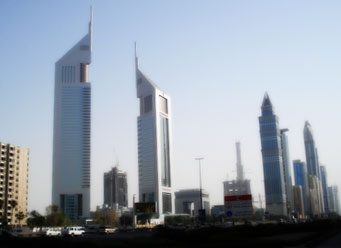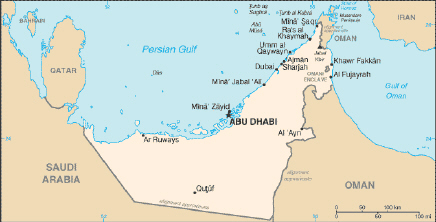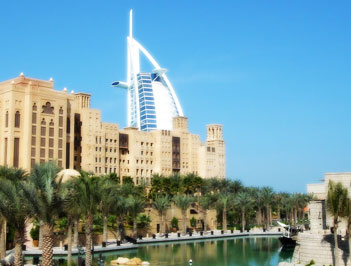

Market of the Month – United Arab Emirates (UAE)
A Business Hub for the Middle East
Market Opportunities and Best Prospects
United Arab Emirates at a Glance
The UAE is a young country, having recently celebrated its 37th year as an independent state. It is open and highly cosmopolitan with a very large expatriate workforce. The UAE is a confederation of seven emirates. The best known is the business center of Dubai. The largest, Abu Dhabi, covers 80 percent of the land mass and holds most of the UAE’s vast oil and gas reserves. The UAE has emerged in recent years as one of the very top markets for U.S. exports in the Middle East/North Africa region, surpassing larger countries like Saudi Arabia and Egypt. While U.S. exports to the UAE in 2000 were only around $2 billion, they now exceed $13 billion.
The combination of vast oil wealth in Abu Dhabi, business acumen on the part of oil-poor Dubai, and the government’s desire to rapidly develop the country has resulted in a sustained boom in business opportunities. In spite of current problems caused by the global financial crisis, the UAE will remain a good market for U.S. firms in infrastructure, oil and gas, defense, greenbuild technologies and services, solar energy, and health care products and services, to name a few.

Abu Dhabi
A Business Hub for the Middle East
The UAE is best known for the city of Dubai, which features the tallest building in the world (Burj Dubai), man-made palm shaped islands (Palm Jumeirah), and other signature projects. Dubai has built itself very successfully into a business, financial and logistics hub for the Middle East, as a bridge between East and West. The Jebel Ali Port is the third largest man-made port in the world and the largest in the region, while Emirate Airline has expanded aggressively to become the leading airline in the region. While there is no doubt that the real estate sector in Dubai is currently facing a shakeout, the role of the city as a regional business center is still strong.
Not content with being outdone by Dubai, the emirate of Abu Dhabi has emerged as the strongest link in the economy, as it controls nearly all of the country’s oil and gas revenue. Abu Dhabi is in a very strong position to ensure the economic stability of the country as a whole, and its own ambitious development plan offers many business opportunities for U.S. firms.
The other five emirates—Sharjah, Ras al Khaimah, Umm al Qaiwain, Ajman and Fujairah—also offer business opportunities as they seek to develop their economies to take advantage of the overall growth in the country’s economy.
The UAE, primarily Dubai, has been touched more severely by the financial crisis than some of its more insular neighbors. The strength of Abu Dhabi is going to ensure that the country as a whole is largely protected from any severe downturn, but sectors such as real estate are experiencing weakness that will result in greater competition chasing fewer projects for the time being. As market conditions are evolving rapidly, U.S. companies should monitor the market closely and be alert for a rebound.
Market Opportunities and Best Prospects
U.S. products, services and companies are highly respected in the UAE for their technological edge, management experience and innovative spirit. With the Emirati Dhiram pegged to the U.S. dollar, currency risk is reduced and competitiveness vis-à-vis the Euro is an advantage for U.S. exporters.
The expansion in direct flights between the U.S. and the UAE also facilitates business. Various airlines have non-stop routes between the U.S. and UAE: Atlanta (Delta), Washington DC (United), New York (Emirates and Etihad), Houston (Emirates), San Francisco (Emirates) and Los Angeles (Emirates).

Map of UAE
The U.S. Commercial Service has identified the following best prospect sectors:
 | Health care products and services |
 | Greenbuild products and services |
 | Power generation |
 | Water and wastewater treatment |
 | Alternative energy |
 | Aircraft parts and services |
 | Pollution control equipment |
 | Safety and security equipment |
 | Defense equipment and services |
 | Air conditioning and refrigeration equipment |
U.S. exporters are encouraged to become familiar with the different markets within the UAE to understand the opportunities and challenges of each. While Dubai is more entrepreneurial, with many free zones offering 100 percent foreign ownership, Abu Dhabi is more traditional, although evolving quickly and with a stronger economy at this time. In most cases, it is important and often required to have a local agent, distributor or representative to assist your firm in building its presence in the market.
The official government language within the UAE is Arabic, but the operational language is English, given that 85 percent of the population is expatriates from more than 100 countries.
Especially when dealing directly with Emiratis, patience, politeness and a willingness to be on the ground are critical to success. Be prepared for often protracted periods of negotiation and bargaining.
Trade shows are also an important part of entry strategy for this market. The UAE is the leading venue for trade shows in the region: ADIPEC is the second largest oil and gas show in the world; Arab Health is the largest health show in the region; IDEX is the largest defense show in the region; and the Dubai Airshow is set to surpass the Paris Air Show in 2009 as the largest aeronautic trade show in the world, to name a few.
United Arab Emirates at a Glance
 | Location: Middle East, bordering the Gulf of Oman and the Persian Gulf, between Saudi Arabia and Oman |
 | Area Total: 83,600 sq km |
 | Border Countries: Saudi Arabia 457 km, Oman 410 km |
 | Coastline: 1,318 km |
 | Climate: Desert; cooler in eastern mountains |
 | Terrain: Mostly flat plain; mountains along southern border |
 | Natural Resources: Petroleum, natural gas |
 | Population: 4,621,399 (July 2008 estimate) |
 | Languages: Arabic (official), Persian, English, Hindi, Urdu |
 | Currency: Emirati Dirham (AED) |
 | Exchange Rate: AEDs per U.S. dollar—3.673 (2007), 3.673 (2006), 3.6725 (2005), 3.6725 (2004), 3.6725 (2003); Note: The AED has been officially pegged to the U.S. dollar since February 2002. |
 | GDP (Purchasing Power Parity): $164.4 billion (2007 est.) |
 | GDP: $192.6 billion (2007 est.) |
 | GDP (Real Growth Rate): 7.5 percent (2007 est.) |
 | GDP per Capita: $16,200 (2007 estimate) |
 | GDP by Sector: Agriculture: 1.8 percent; industry: 60.6 percent; services: 37.6 percent (2007 est.) |
 | Labor Force: 3.065 million (2007 est.) |
 | Government: Federation with specified powers delegated to the UAE federal government and other powers reserved to member emirates |
 | Chiefs of State: Prime Minister and Vice President MUHAMMAD bin Rashid Al-Maktum (since Jan. 5, 2006); Deputy Prime Ministers SULTAN bin Zayid Al-Nuhayyan (since Nov. 20, 1990) and HAMDAN bin Zayid Al-Nuhayyan (since Oct. 20, 2003) |

Abu Dhabi
Plan your market entry the right way. Use U.S. Commercial Service market research to learn about your product’s potential in the UAE, the best prospects for success, and the market’s business practices before you export. For more information, please visit the Market Research Library.
>More about United Arab Emirates